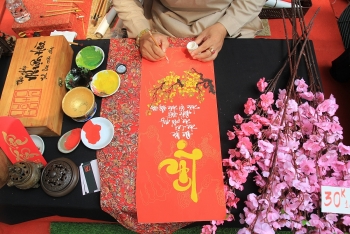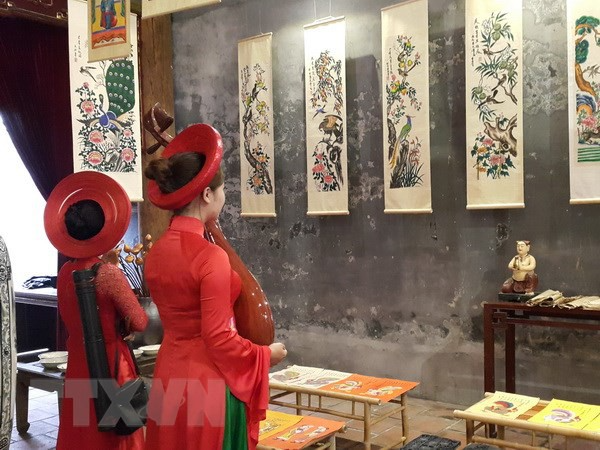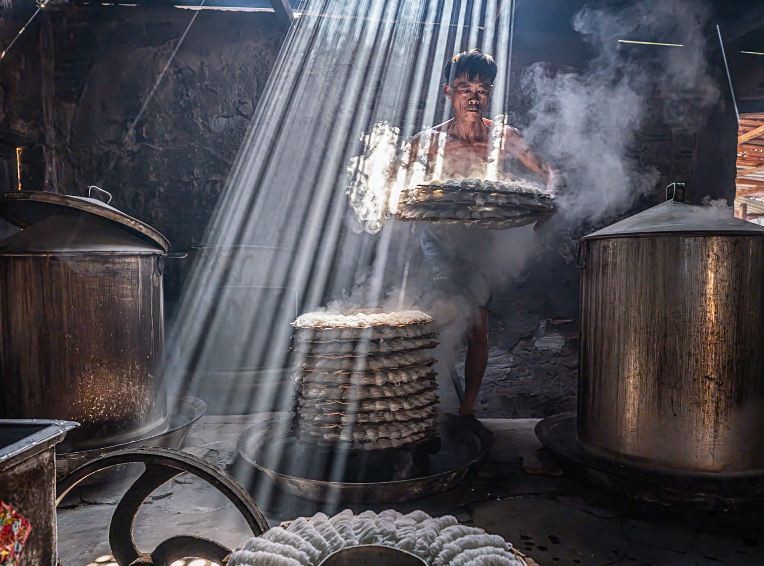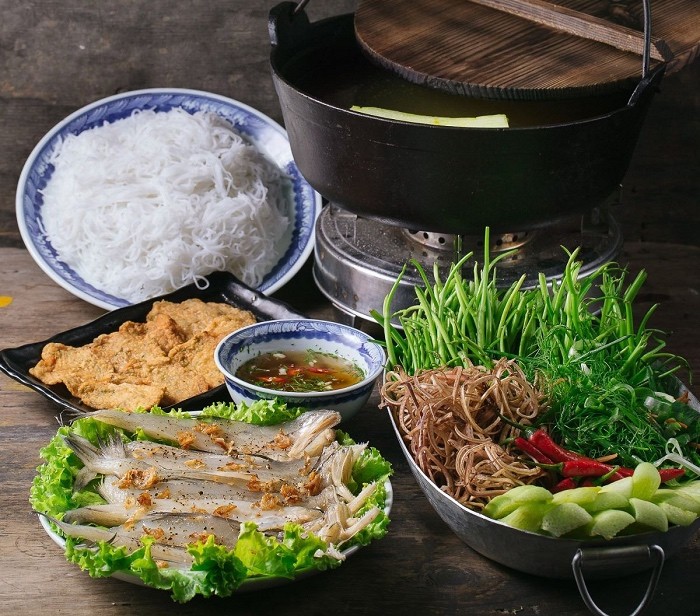7 unusual Vietnamese food dishes amazing tourists
| Traditional pottery village busy preparing for Tet | |
| Exploring unique lunar New Year markets in Ho Chi Minh City | |
| Hanoi to recreate traditional Tet Holiday in Hanoi's Old Quarter |
It is likely that some traditional Vietnamese dishes will excite the most adventurous: for example, 'weird' dishes including blood or organ soup, or the famous fertilized duck egg and all very common in Vietnamese eating habits and easy to find on street food markets, but some tourists may find them difficult to eat because of its peculiarity.
Now without further ado, let’s explore the uncommon food you can try when traveling in Vietnam.
Trung vit lon: fertilized duck egg
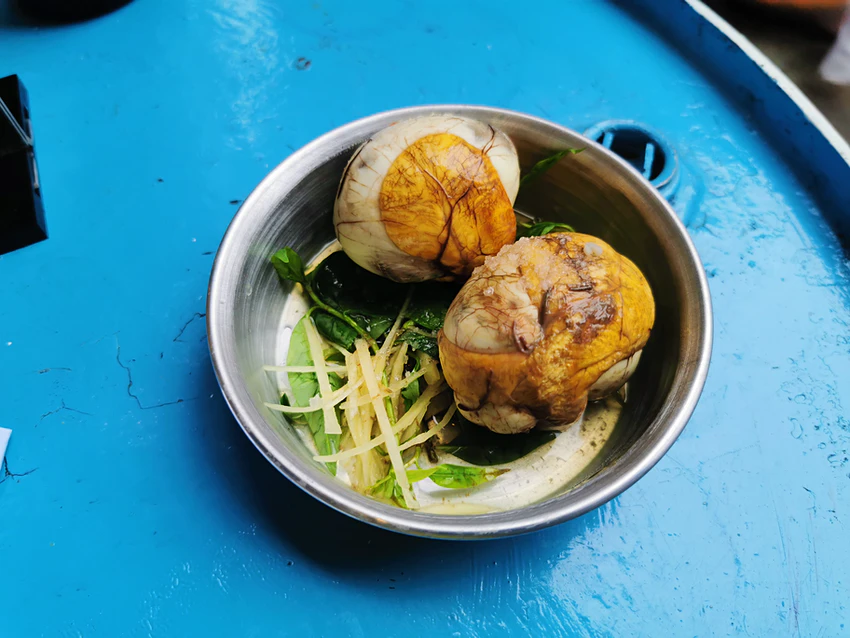 |
| Trung vit lon is fertilized duck egg and very popular in Vietnam © Fabienne Fong Yan |
Fertilized duck egg is a very popular type of street food in Asian countries, especially in Philippines and Vietnam. The word Balut is originated from the Philippines, while in Vietnam, it is often called Trung vit lon or Hot vit lon. A balut looks like a normal duck egg, but have developing bird embryo inside for about 18 days.
When you break the shell of a balut, you should be careful not to let the liquid ooze out. The liquid inside the balut tastes a bit like chicken soup but has a much stronger flavour. The egg yolk texture tastes soft and sweet, quite similar to custard and the embryo is much like a poached chicken. The egg white is much more firm than a hard-boiled egg, a bit rubbery but not unpleasant.
It is appreciated as a rich source of protein and Vietnamese children as used to having them for breakfast. They can be enjoyed with basil leaves and salted lime chili sauces.
Each region has a different way to enjoy Balut. For instance, in Hanoi, the eggs are removed from the shell and put right into a small bowl (they do not use cups) and use a small spoon to eat. In Southern Vietnam, after boiling, baluts are placed in a small cup, large egg head upward, then just gently peel the top of this with your fingers, the sprinkle with a little black pepper and salt.
If you’re too intimidated by the big duck egg, another variant is trung cut lon: fertilized quail eggs, smaller, so easier to eat. A very popular way to prepare those is warmed up in tamarind and lemongrass sauce (trung cut lon xao me) – a dish commonly served in the afternoon.
Ga tan den: black chicken in herbal soup
This soup is very common in Vietnamese diets and highly appreciated for its medicinal virtues. The broth is made from Chinese medicinal herbs and dried fruit (including mugwort, dried date and goji berries) and a very bitter rhizome that is not supposed to be eaten, but gives taste to the soup.
Ginseng and chicken are a beautiful marriage of healing benefits and flavour. Chinese ginseng chicken soup incorporates some unique ingredients, setting the soup apart from versions of other oriental culture. The value of ginseng and Silkie chicken are evident in Chinese medicine, as ginseng and silkie chicken soup is often served to the very special people at special occasions, such as the elderly with weakened health, a pregnant woman, a postpartum mother serving her confinement, a hard-working student studying for a big exam, or a patient recovering from a surgery.
The soup can be prepared with ordinary light-flesh chicken but the black chicken, from a special Vietnamese breed, is the most unique version of this healthy soup. It is highly recommended by locals, for women in particular.
Chan ga: Chicken feet
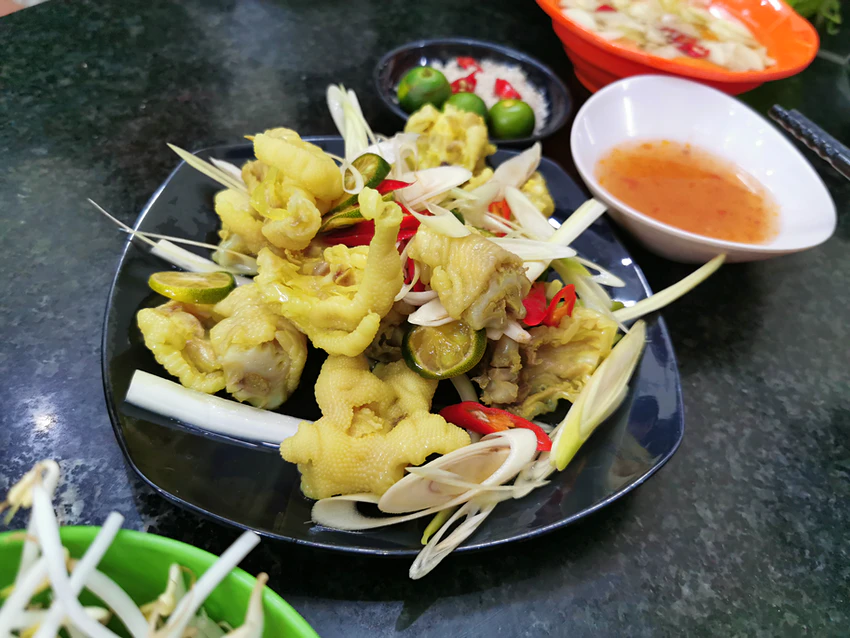 |
| Chan ga (chicken feet) with lemongrass and chilli © Fabienne Fong Yan |
While some people love ready-to-eat chicken served at fast food chains, many Vietnamese people still prepare chicken dishes by themselves because they love cooking at home for nutritional and safe meals for daily life. The dish has become popular among Vietnamese, especially teenagers who are avid snackers and men who want to take something with beer.
Chicken feet are very common in Vietnam and can be found literally everywhere. Although not expensive, they can still be considered a delicacy. Chicken feet can be fried with chili and honey sauce, or boiled and served with ginger and lemongrass in a traditional seasoning. It’s a dish usually ordered on the side, with a hot-pot. Because of that, chicken with huge feet are a special breed in some Vietnamese villages. Breeders are very proud and people can go crazy for them.
Blood soup and animal organ soups
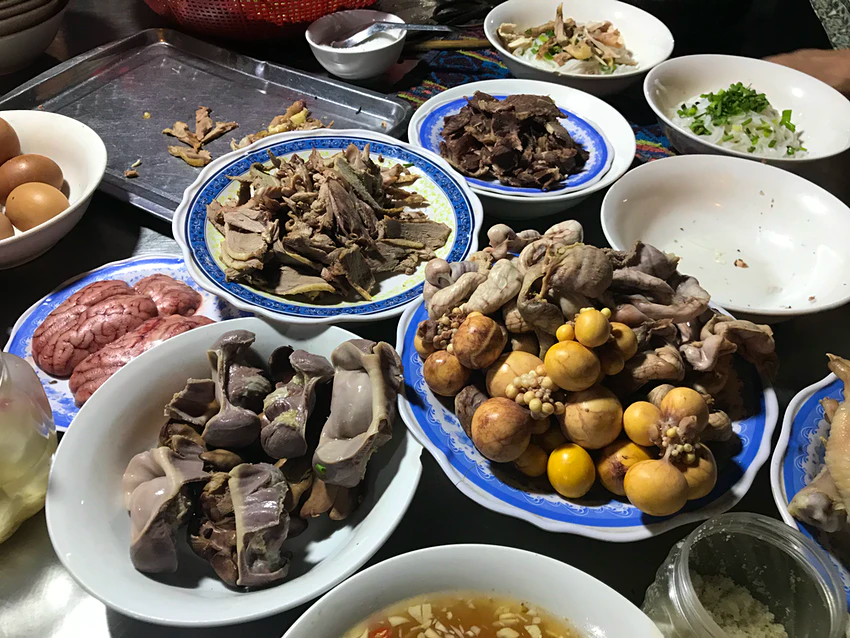 |
| Pork brains and duck organs are among the soup ingredients on a street food stall © Fabienne Fong Yan |
The raw blood of ducks, geese, or pigs comprise tiết canh, a traditional Vietnamese dish known as blood soup. To make tiết canh, cooks first blend the blood with a saline mixture or diluted fish sauce to keep it from coagulating too quickly. Then they season the mixture, add baked or fried meat, and set it aside. Once the blood coagulates into a cool, silky pudding, it’s topped with basil, mint, or onion, and peanuts for an added crunch. Strong alcohol, usually rice wine, accompanies the final product. Tiết canh’s biggest fans rave about it, declaring it at once buttery and sour, with a gelatinous texture. Critics, however, describe a metallic taste.
A more common sight on markets is animal organ soup. They can be from pigs, beef , duck or chicken. On night street food stalls, it is not unusual to see a display of all possible organs, so you can choose which you want in your broth. Options can include duck liver, pig brains, beef intestines or stomach, or more ordinary pig knuckles and feet. The recipes for organ soups or soups using uncommon parts of the animals are diverse and they show the resourcefulness and no-waste policy of the Vietnamese when it comes to food.
Oc: Sea snails dishes
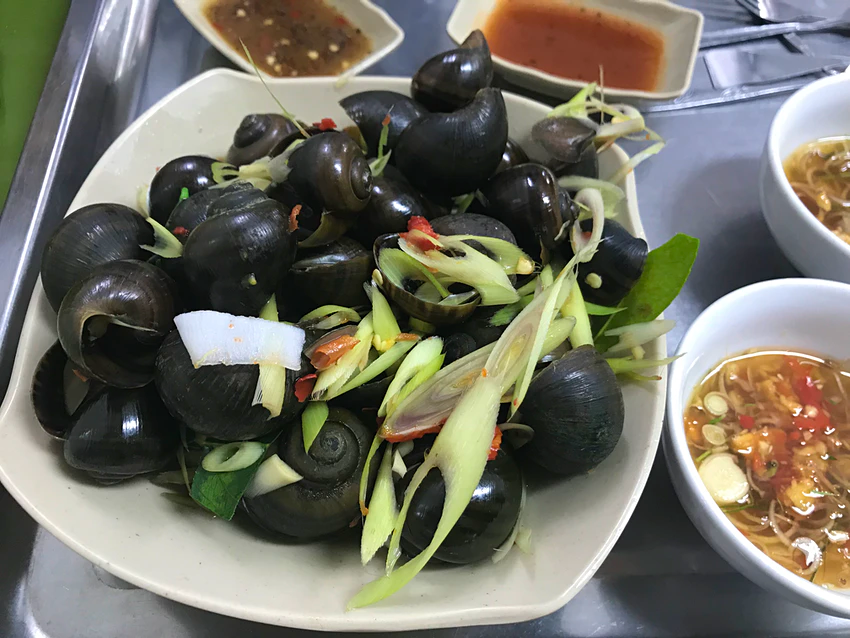 |
| Sea snails are very popular, particularly in north Vietnam © Fabienne Fong Yan |
When you picture eating snails, you may think of a buttery French delicacy. But halfway across the world, there's another type of snail that is just as popular. And it's called ốc, or "sea snails." In the streets of Vietnam, people have been eating them for centuries.
Many Vietnamese love to eat snails – not only because they are delicious – but also because they are a wonderful social food to share among friends and family.
Snails are available mainly in the evening (Vietnamese dishes are served following a schedule throughout the day and dishes served at night can only be found then) and there is a clear protocol as to how you order them: first choose the type of snails you want, then the way you want them cooked and finally, your sauce or seasoning. Popular ingredients include lemongrass and ginger, tamarind sauce, and green onions.
Raw octopus with “mam tom”, fermented shrimp paste
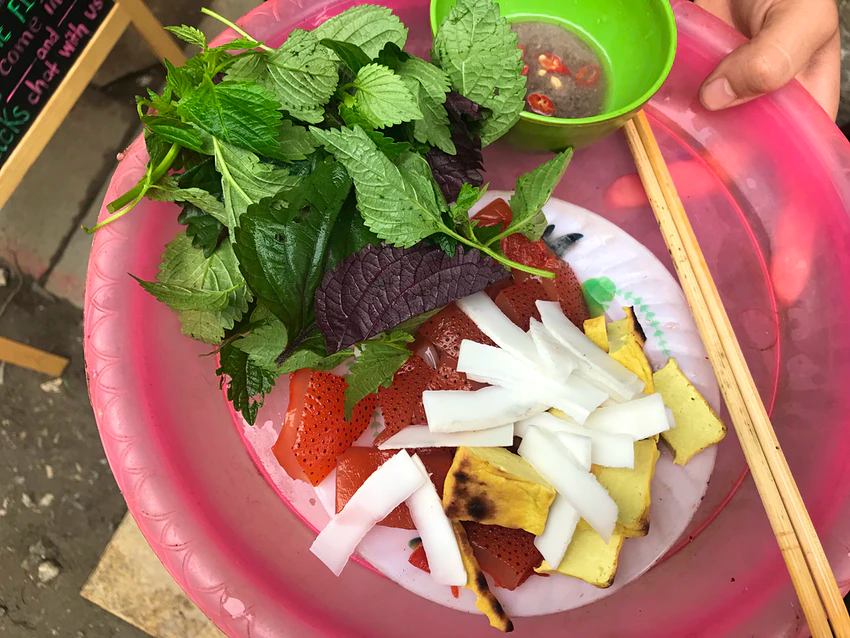 |
| Mam tom © Fabienne Fong Yan |
This is a dish you might not see everywhere: raw octopus can be found with mobile vendors who ramble the streets of Hanoi in the morning. Although not so tasty, the Vietnamese eat it for its texture, and all its taste comes from the aromatic herbs (mint and perilla) and most of all, the fermented shrimp sauce. The latter, called 'mam tom', is a surprising food in itself: it is so strong, salty and pungent that the Vietnamese say if you can eat it, it makes you Vietnamese.
It is the traditional dipping sauce for Hanoi Fried Fish with Turmeric and Dill (Cha Ca La Vong).
Mam Tom is not for the faint of heart. It has a strong and pungent smell. It’s made from a mixture of fermented shrimp paste, fresh crushed garlic, water and lemon juice.
Silkworms, river worms and other worm dishes
Grilled silkworms nymphs (con nhong) are a very common street food find. They are valued for their protein and mineral qualities. In the north in particular, silkworms are bred on mulberry leaves in villages. When prepared for food, they are dried and mixed with salt in order to be fried with fish sauce. You can find them easily as a staple dish served in 'com binh dan', rice buffet places, so it’s not difficult to find if you want to try it.
Since we are talking about worm dishes, let’s mention the beetle larva – or coconut worm, consumed especially in the area of the Mekong Delta, in southern Vietnam. Contrary to the silkworm, this worm is eaten live, dipped in fish sauce. People say you must bite the head off it first; otherwise it will bite your tongue...I must admit this one sounds scary.
Another type of worm used in typical dishes is the river worm. It is prepared in a fried omelet, mixed with pork meat. This dish is called 'cha ruoi'. Why eat the river worm? It is said to be very nutritious and good for arthritis or physical aches. The worms are rather easy to find on markets, in the fresh fish and seafood section.
As we say, “one man’s food is another man’s poison”. Don’t judge local food habits when traveling: you might end up liking some of those dishes and if not, there are plenty of other food options in Vietnamese street food stalls, markets and restaurants.
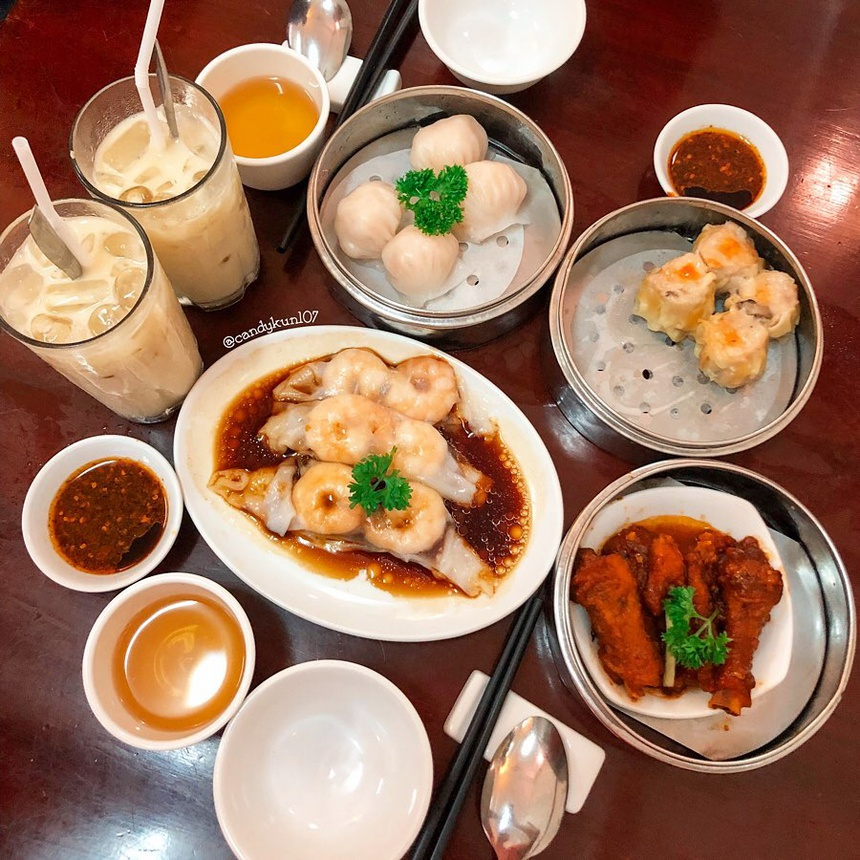 | 4 Famous Chinese dimsum restaurants to dine in Ho Chi Minh City Dimsum is a traditional cuisine in China, a large range of small dishes that are served in restaurants for breakfast and lunch. The hearty meal ... |
 | Vietnam seeks to become world's lead in seafood production and exports Vietnam is determined to become a deep seafood processing centre under a national seafood development strategy towards 2030. The country is expected to join top ... |
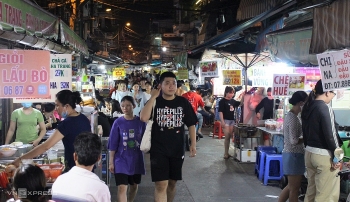 | Exploring street food paradise at Sai Gon flower market Ho Thi Ky flower market, one of the most famous flower markets in Ho Chi Minh City, will not fail to entertain you with beautiful ... |
Recommended
 National
National
Shangri-La Dialogue 22: Vietnam Highlights Some Issues of Ensuring Stability in a Competitive World
 National
National
Vietnam News Today (Jun. 3): PM Pham Minh Chinh to Attend UN Ocean Conference, Visit Estonia, Sweden
 National
National
Vietnam News Today (Jun. 2): Vietnamese Trade Mission Sounds Out Business Opportunities in United States
 National
National
Vietnam News Today (Jun. 1): Vietnamese, Japanese Firms Foster Partnership
 National
National
Vietnam News Today (May 31): Vietnam Strongly Supports Laos’s National Development
 National
National
Vietnam News Today (May 30): Vietnam, Venezuela Reinforce Ties Through People-to-people Diplomacy
 National
National
Vietnam News Today (May 29): Vietnam and Hungary to Expand Cooperation into New Areas
 National
National


